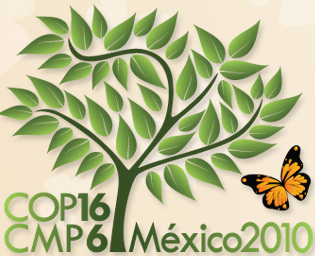Blood
Blood began to flow early at the Moon Palace Hotel, as delegates danced to the 2010 United Nations Climate Change Conference theme song – “Let’s put the CAN in Cancun!”
Twelve months after Hopenhagen, it is all happening again, this time on Mexico’s Yucatan Peninsula. The 15,000+ representatives from 193 countries were greeted by tropical treats on opening night: salsa, karaoke, twanging guitars, stilt walkers in sombreros, tequila, anthropogenic carbon dioxide emissions and cocktails of ad hoc credulity.
The Cancun conference’s official title is: “the 16th session of the Conference of the Parties (COP 16) to the United Nations Framework Convention on Climate Change (UNFCCC) and the 6th session of the Conference of the Parties serving as the meeting of the Parties (CMP 6) to the Kyoto Protocol.”
In addition, two permanent UNFCC entities – the Subsidiary Body for Scientific and Technological Advice (SBSTA) and the Subsidiary Body for Implementation (SBI) – are holding their 33rd sessions.
Two ‘temporary subsidiary bodies’ – the Ad Hoc Working Group on Further Commitments for Annex I Parties under the Kyoto Protocol  (AWG-KP) and the Ad Hoc Working Group on Long-term Cooperative Action under the Convention (AWG-LCA) are also meeting there.
(AWG-KP) and the Ad Hoc Working Group on Long-term Cooperative Action under the Convention (AWG-LCA) are also meeting there.
Christiana Figueres, however, was not dancing, at least not yet. She was too busy in conversazione with the delegates – and an ancient Mayan jaguar (and weather) goddess. The UNFCC’s new Costa Rican executive secretary used her opening statement to urge attendees to embrace the wisdom of Ixchel.
Ixchel? She was a moon goddess, Figueres explained, “the goddess of reason, creativity and weaving. May she inspire you — because today, you are gathered in Cancun to weave together the elements of a solid response to climate change using both reason and creativity.”
Ixchel, or Ix Chel, was a winning – or disturbing – choice, depending on your carbon politics and religion. The “high-segment” audience fortunately was spared details of the goddess’s darker – and bloodier – side. Could a formidable old woman with a writhing serpent headdress and crossed bones embroidered on her skirt ever be reasonable?
She was actually a moody and malevolent goddess, motivated more by divine wrath than Socratic reason. As for weaving, Ixchel’s only tapestries were destructive floods and storms. Was this why she apparently had become the unofficial patron saint for pagan climate alarmists and decarbonistas?
Ixchel is often depicted as a female warrior or ‘war woman’ (mujer guerrera), with a gaping mouth suggesting cannibalism. In this manifestation, she is insatiably hungry for new victims. Climate change sceptics and deniers are high on her favourite takeaway menu.
As a consort of Itzamna, ‘lord of the heavens’, she also demanded human sacrifice. The Spanish conqueror, Cortés, wrote about a place in Acalan where unmarried young women were sacrificed to a "goddess in whom they put great trust and hope", possibly Ix Chel.
According to Bernardino de Sahagun (1540–85), victims were taken to the top of a teocalli and laid on a stone slab. Abdomens were sliced open with a ceremonial flint knife. Still-beating hearts were pulled out by priests and placed in a bowl held by a statue of the honoured goddess. Bodies were thrown down the temple stairs.
Reducing human carbon (dioxide) emissions will not work, as I argued in two recent papers, Re-interpreting Codex Cihuacoatl: New Evidence for Climate Change Mitigation by Human Sacrifice and The Aztec Solution to Climate Change. What will work is not for the squeamish.
The Mayans had a sense of sacred obligation, eerily similar to our concern for the environment. Without constant sacrifices, they believed the sun would become “angry”, temperatures would rise, corn yields decline and their world faced with imminent destruction. (Had they had the option of jetting off to international conferences at fabulous locations every few months it might have been a different – and less macabre – story.)
The President of Mexico, His Excellency Felipe Calderon, also spoke on the 7th December of the danger of failing to face up to the challenge of climate change “The atmosphere is indifferent to the sovereignty of states,” he said. “It would be a tragedy if our inability to see beyond our personal interests, our group or national interests makes us fail.”
The President stressed Mexico’s vulnerability to “climate change impacts”. The country’s recent record-breaking drought and intense hurricane season had displaced thousands and caused 60 deaths. “Climate change,” he declared, “is beginning to make us pay for the fatal errors we as humanity have committed against the environment”. What were once described as acts of God have become acts of Climate Change, even in Catholic Central America.
Yet Mexico faces a more immediate – and dangerous – threat. Cancún has become an important trans-shipment point for Colombian cocaine, a centre of money laundering, drug smuggling and lethal cartel conflict. Humans are spilling much more blood in the country than the forces of Nature. Drug-related violence has claimed over 28,000 lives since early 2007.
Sweat
Sweat also flowed early at the Moon Palace Hotel. (Average maximum and minimum temperatures for December are 28C and 21C, with 96mm rainfall.) The tropical heat and humidity, however, were not the primary causes of anxiety among delegates. 
“The environmental stakes are high,” warned Figueres, “because we are quickly running out of time to safeguard our future.” The political stakes were high too, she added, as “the effectiveness and credibility” of the multilateral process was in danger.
Figueres emphasised three issues. According to the UN World Meteorological Organization, concentrations of atmospheric greenhouse gases (human and natural, but excluding the most abundant one, water vapour) are at their highest level (0.0385 per cent) since pre-industrial times (translation: Despite considerable uncertainty about the precise relationship between anthropogenic carbon dioxide and global temperature, the WMO asserts more carbon dioxide means higher temperatures, more extreme weather and so on).
Secondly, the poorest and most vulnerable people are already facing climate impacts and urgently need assistance (payment of “climate debt”) to tackle “a problem that they did not cause” (translation: Every destructive weather/climate event in the developing world is caused by greenhouse gas emissions – primarily carbon dioxide – from the developed world).
Thirdly, multilateral UN climate change process should remain “the trusted channel for rising to the challenge” (translation: Success is desperately needed here to validate the process and to justify future climate COPs).
Time was running out for an agreement to supersede the Kyoto Protocol. Executed on 11th December 1997, it expires on 11th December 2012. This is not any old date. Ominously, it is only ten days from what some believe will be a momentous event in world history. The 21st December 2012 is the end of a 5,125-year Long Count cycle on the Mayan calendar.
One of the few representatives of the Maya, Don Alejandro Cirilo Perez Oxlaj, Head of the National Maya Council of Elders of Guatemala, has expressed incredulity at the current obsession with climate apocalypse. For the Maya, the end of one Long Count cycle is merely how the gods make way for the next one. Down at the Moon Palace Hotel, however, some doubtless see this impending transition from the Fourth to Fifth Sun as a societal "paradigm shift". For them, it will be either an evolutionary step forward to global eco-consciousness and a decarbonised Eden, or backward to oblivion. Climate action now!
Tears
There were tears too. Vicky Pope, head of the climate predictions programme at the UK Met Office’s Hadley Centre, possibly shed some when stranded at Gatwick airport last week. She was one of many millions caught by a brutal – and unpredicted – cold snap, Pope was on her way to Cancún to announce, together with the UN WMO, that 2010 had tied (provisionally) with 1998 as “the hottest year on record.”
According to the WMO, “the global combined sea surface and land surface air temperature for 2010 (January–October) is currently estimated at 0.55°C ± 0.11°C1 (0.99°F ± 0.20°F) above the 1961–1990 annual average of 14.00°C/57.2°F. At present, 2010’s nominal value is the highest on record, just ahead of 1998 (January-October anomaly +0.53°C) and 2005 (0.52°C).”
We live, alas, in a murky world of lies, damned lies and climatological normals. Had the WMO used a different “standard reference period”, such as the 1981-2010 annual average, instead of a 1961-1990 annual average, the global combined sea surface and land surface air temperature anomaly for 2010 (January – October) would have been 49 per cent lower at only +0.28C.
Meanwhile, Britain is experiencing its coldest December in a century. Overnight lows on 8th December were -15C in Scotland and -13C in England. As the Army cleared away snow, frustrated experts claimed the snap was a ‘once in a lifetime’ extreme event in a warming world.
The most tearful, however, could be all the delegates who so earnestly want to put “the CAN in CANCUN!” They accept the UNFCC storyline that governments actually can manipulate the Earth’s elusive thermostat and control global temperatures. They accept all the frantic “wake-up calls’. They believe, for example, that Tuvalu, The Maldives, Kiribati, Vanuatu, etc, will have to evacuate “their entire populations because of salt water intrusion and sea level rise.”
At COP-16, sacrificial victims are not laid on a stone slab. They are taken into a room and subject to hand-wringing, mind-bending and heart-rending eco-sentiment about saving the planet.
If Figueres is right, Cancun will be an “insufficient” but “necessary step” to COP-17 – and beyond.
Stand by for more lachrymose moments south of the border, down Yucatan way, with or without Ixchel’s help.
Michael Kile is author of a recent paper on ancient Mesoamerica, “The Aztec solution to climate change”.
References:
Kyoto Protocol to United Nations Framework Convention on Climate Change, United Nations, 1998.
Michael Kile, 2009, “The Aztec solution to climate change”.
http://www.guardian.co.uk/environment/2010/may/18/christiana-figueres-climate-chief-un
 Sign In
Sign In 0 Items (
0 Items ( Search
Search









